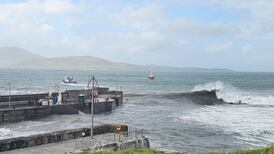In deference to my first-hand knowledge of island living, I’ve called my coronavirus confinement journal my Alcatraz Diary. Unlike Clint Eastwood’s character, Frank Morris, in the famous film, my escape back to the mainland didn’t involve digging any tunnels or underwater swimming.
Indeed, now that restrictions have eased I can gaze at my former home, Clare Island, from a rosary of Clew Bay beaches without fear of being shackled by the Fuzz.
The pandemic has made the offshore islands of Ireland into worlds apart again – unreachable places of our imaginations where the ghosts of John Millington Synge and Peig Sayers are free to roam without fear of being asked directions to the nearest café or pub by wide-eyed tourists.
Perhaps this hiatus from the onslaught of hordes of visitors escaping from an increasingly globalised world is a blessing in disguise? Perhaps it is giving these special outposts a chance to breathe in the ocean air again, treasure the unbridled beauty of their home-place, and count the pebbles on the beaches.
There is no doubt that these communities will adapt to the new circumstances. It is in their race memory to be self-sufficient and to survive.
Anthropologist Robin Fox encapsulates the spirit of islanders so poetically and pithily in his 1995 book The Tory Islanders: A People of the Celtic Fringe. “At the very highest universal level, Tory represents a hymn to the human spirit. Humanity consists here not only in heroism, although there is that too, but in many little things that collectively make a viable way of life in the teeth of the odds.”
This makes me think of a winter in the late 1980s when one storm after another meant we in Clare Island were cut off from the mainland for weeks on end.
It was back in the days when the piers were shorter, the boats were smaller and the world beyond the waves and the swell often became an exotic mirage.
Dancing at the crossroads took on a whole new meaning that winter as we discovered an Inuit condition called pibloktoq.
Also known as Arctic hysteria, the Inuit would take to the tundra and carry out all sorts of daft or dangerous feats after particularly harsh winter conditions.
So I imagine when the late Clare Island philosopher Michael Joe O’Malley streaked from his home in the village of Ballytoughy Mór back in the 1930s it was after a long spell of bad weather.
I’m guessing too it was after a barrage of hailstone showers as big as golf balls, and winds that would put the heart crossways in a banshee, that a daredevil lighthouse keeper walked atop the railings outside the lantern gallery. A feat not for the faint-hearted, one even a Bolshoi ballerina might baulk at. Of course he could have imbibed some of Michael Joe’s hooch but Clare Island lighthouse teeters on the edge of 250ft cliffs, so he wouldn’t have wanted to be seeing double.
Our island communities have long ago become inured to the whims of the weather and its diktats of isolation. They know better than any of us that the calm comes after the storm, that life readjusts and finds a new balance, a delicate new equilibrium.
Clare Island lost half of its population to the Great Famine. Later, in the 1890s, when the landlord sent a gunboat to impound their cattle, the islanders had already secreted them to the mainland peninsula of Corraun. Down the coast the entire population of Inishturk was evicted in 1851 after Lord Lucan’s bailiffs with a large force of constabulary razed their houses to the ground. In time, they returned – one family after another.
As Robin Fox observes: “The full gamut of social processes is run on Tory island. There is absolute cumulative change through time. There is abrupt social transformation. There is nice balanced equilibrium. Above all there is survival. The islanders are masters of it. They will change the rules, change the strategies, change the game but they will survive.”
Indeed, they are the masters and mistresses whose historical narrative resonates during these uncertain days.









